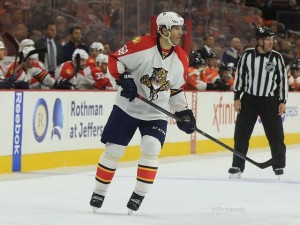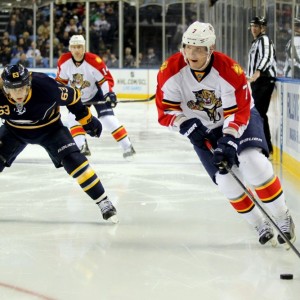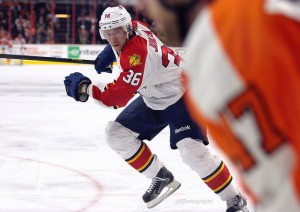After taking the red-hot Dallas Stars to the proverbial woodshed Saturday night, the Florida Panthers awoke Sunday morning in third place in the Atlantic Division. Though they’ve played just eight of eighty-two games, the Panthers are now exactly where they want to be next April: in the thick of the playoff race. Whether or not they finish the regular season where they’ve started remains to be seen, but expectations are high in Sunrise. Those expectations raise an important question: Are the Florida Panthers ready for prime time? A look at the Cats’ current composition is quite revealing.
Oldest Team in the NHL…Really?

Considering the Panthers’ roster features ten players drafted by the organization since 2009, it may come as a shock to learn they’re the oldest team in the NHL, with an average age of 28.32 years. The average is inflated, however, by Florida’s five “geriatrics” (at least in hockey terms). These five players are all 36 or older, led by 43-year-old current team scoring leader Jaromir Jagr. The roster breaks down like this (all ages as of February 1, 2016):
- Under 24: 5 Forwards, 2 Defensemen (Barkov, Bjugstad, Brickley, Huberdeau, Trocheck, Ekblad, Petrovic)
- Ages 24-29: 4 F, 4 D (Bolland, Howden, Pirri, Smith, Gudbranson, Kampfer, Kulikov, Olsen)
- 30 and Up: 4 F, 2 D, 2 G (Jagr, Jokinen, MacKenzie, Thornton, Campbell, Mitchell, Luongo, Montoya)
This team is actually younger than the above breakdown indicates, as four of the eight 24- to 29-year-olds will be 24 as of February 1, 2016, two will be 25 years of age and at 27 and 29, respectively, Kampfer and Bolland are the outliers of the bunch. This middle group is significant: Several studies point to skaters’ peak performance years occurring from ages 24 to 29. Should the Panthers qualify for the postseason next spring, they’ll enter the playoffs with just eight players in their prime. Is this good or bad? To determine that answer, we first need to know how Florida compares with the rest of the league.
Prime Time Players Across the NHL
League-wide, and excluding goalies (because they develop, peak and decline at different rates than skaters), the average NHL roster features 10.1 “prime time” players (note: all ages are as of February 1, 2016, and all roster and age data are taken from hockey-reference.com). These peak performers are distributed across the league as follows:
- 7 Players: Colorado, Winnipeg
- 8: Arizona, Carolina, Calgary, Florida, Minnesota, Montreal, St. Louis, Vancouver
- 9: Buffalo, Dallas, New Jersey, New York Rangers, San Jose, Tampa Bay
- 10: Columbus, Ottawa
- 11: Anaheim
- 12: Edmonton, Los Angeles, Nashville, Toronto, Washington
- 13: Chicago, Detroit, Philadelphia, Pittsburgh
- 14: Boston, New York Islanders

Two things are readily apparent here. First, Florida is at the low end of the scale. Second, based on early-season standings, the relationship between the number of prime players and overall team performance would seem murky, at best. The Bruins and Islanders, for example, each have fourteen prime timers, yet the former is on pace for 82 points, while the latter is winning at a 113-point clip. Since the ultimate goal is to hoist the Stanley Cup, perhaps comparing the Panthers to the last ten Cup winners and losers would make more sense.
Don’t Forget the Wily Vet
Over the last ten seasons, the average Cup winner has iced a roster including 9.8 prime time players. Curiously, the rosters of Cup runners-up during that span have averaged 12.1 prime timers. At first glance, it would seem those numbers should be reversed; after all, shouldn’t the team with the most players at peak performance levels win? The results show the opposite:
Stanley Cup finalists with more prime timers than their opponent are 1-7 over the last ten years (in 2013 and 2015, the teams had an equal number of prime timers).
One possible explanation is that the more prime timers a team ices, the fewer over-30 veterans they carry on the roster. Particularly at playoff time, the so-called “wily vet” is worth far more than his diminished offensive output, as intangibles such as leadership and first-hand knowledge of the effort and sacrifice necessary to hoist the Cup really come into play. The last ten Cup winners averaged 7.7 over-30 skaters, compared to 6.1 for runners-up.

With six over-30 skaters, the Florida Panthers boast veteran experience on par with the 2013 Chicago Blackhawks and 2014 Los Angeles Kings, so they can probably check off the “veteran” box. Eight peak performers is low, but Detroit won with eight in 2008, Carolina won with seven in 2006 and Pittsburgh claimed the Cup in 2009 with just four players in their prime, so the Panthers could still be in the hunt.
The Wild Cards
Of course, the 2009 Penguins also had two youngsters named Crosby and Malkin, who were just 21 and 22, respectively. Those under-24 “Not Ready for Prime Time Players” are wild cards, as their performance levels can vary widely. The Panthers have seven such wild cards, and while none rise to the level of the Pens’ super duo, Jonathan Huberdeau is rapidly blossoming into a top-level talent, as was Sasha Barkov before his hand injury, while 23-year-old Nick Bjugstad is already a force to be reckoned with down the middle of the ice and 2015 Calder Memorial Trophy winner Aaron Ekblad continues to develop.
Florida has the prime time players. They’ve got the wily vets. To make it into the playoffs and to make some noise once they get there, the Panthers just need some of their wild cards to step up.